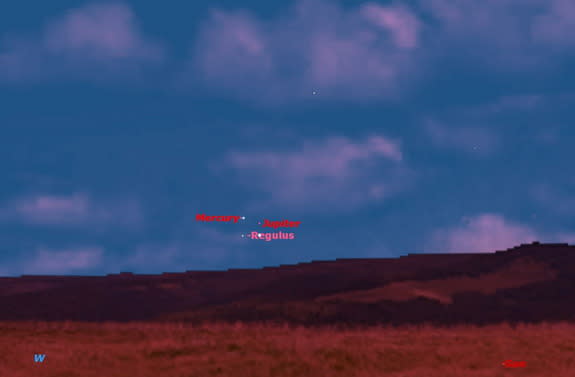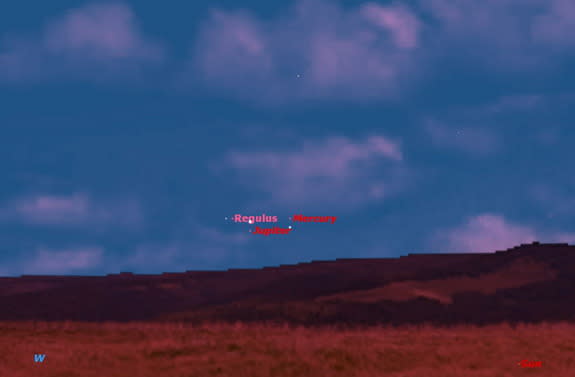See Mercury, Jupiter and Bright Star Form a Celestrial Trio at Sunset
Over the next few nights, observers with clear skies and a great view of the low western horizon may be able to observe a triple conjunction between the planets Mercury and Jupiter and the bright star Regulus.
Look for this celestial trio tonight (Aug. 7), with Jupiter, Regulus and Mercury aligning to form an equilateral triangle in the western night sky that measures about 1 degree per side. Mercury will be on top, Regulus to the left, and Jupiter to the right.
Currently, Jupiter is the brightest of the three, at magnitude –1.7. Mercury is shining with a magnitude –0.7, while Regulus is the faintest of the three, with a magnitude +1.3. Brightness in astronomy is measured on an upside-down scale where the faintest stars visible to the naked eye are magnitude 6, the brightest stars are around magnitude 0, and really bright objects like the sun, moon, and planets have negative magnitudes. [Related: Best Planets to See This August]
All three of these objects will be very bright, but will be masked by the brightness of the sky just after sunset. If you wait until the sky has darkened, they will probably be too low to observe.
Three nights later, on Monday (Aug. 10), Mercury will have moved away to the left, but Regulus and Jupiter will have moved closer to each other, less than half a degree apart. This conjunction will be very hard to observe because of its low altitude.
This will probably be your last chance to observe Jupiter before it passes behind the sun on Aug. 26. Look for it in the morning sky in mid-September.
Jupiter, Mercury and Regulus actually began their celestial display earlier this week on Wednesday (Aug. 5). At the time, the two planets and star formed a straight line less than 4 degrees long, fitting comfortably in the viewing field of a good pair of binoculars.
Editor's note: If you capture an amazing view of Jupiter, Mercury and Regulus that you'd like to share with Space.com for a story or gallery, send images and comments in to: spacephotos@space.com.
This article was provided to SPACE.com by Simulation Curriculum, the leader in space science curriculum solutions and the makers of Starry Night and SkySafari. Follow Starry Night on Twitter @StarryNightEdu. Follow us @Spacedotcom, Facebook and Google+. Original article on Space.com.
Copyright 2015 SPACE.com, a Purch company. All rights reserved. This material may not be published, broadcast, rewritten or redistributed.

 Yahoo News
Yahoo News 

